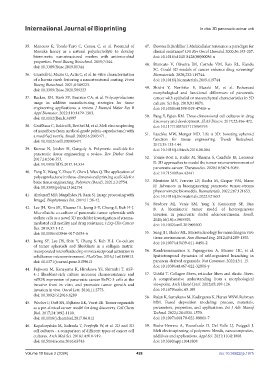Page 436 - IJB-10-2
P. 436
International Journal of Bioprinting In vitro 3D pancreatic acinar unit
35. Mancuso E, Tonda-Turo C, Ceresa C, et al. Potential of 47. Desoize B, Jardillier J. Multicellular resistance: a paradigm for
Manuka honey as a natural polyelectrolyte to develop clinical resistance? Crit Rev Oncol Hematol. 2000;36:193-207.
biomimetic nanostructured meshes with antimicrobial doi: 10.1016/s1040-8428(00)00086-x
properties. Front Bioeng Biotechnol. 2019;7:344. 48. Brancato V, Oliveira JM, Correlo VM, Reis RL, Kundu
doi: 10.3389/fbioe.2019.00344
SC. Could 3D models of cancer enhance drug screening?
36. Giuntoli G, Muzio G, Actis C, et al. In-vitro characterization Biomaterials. 2020;232:119744.
of a hernia mesh featuring a nanostructured coating. Front doi: 10.1016/j.biomaterials.2019.119744
Bioeng Biotechnol. 2021;8:589223.
doi: 10.3389/fbioe.2020.589223 49. Shichi Y, Norihiko S, Masaki M, et al. Enhanced
morphological and functional differences of pancreatic
37. Backes, EH, Harb SV, Beatrice CA, et al. Polycaprolactone cancer with epithelial or mesenchymal characteristics in 3D
usage in additive manufacturing strategies for tissue culture. Sci Rep. 2019;9:10871.
engineering applications: a review. J Biomed Mater Res B doi: 10.1038/s41598-019-47416-w
Appl Biomater. 2022;110:1479-1503.
doi: 10.1002/jbm.b.34997 50. Fang Y, Eglen RM. Three-dimensional cell cultures in drug
discovery and development. SLAS Discov. 2017;22:456-472.
38. Großhaus C, Bakirci E, Berthel M, et al. Melt electrospinning doi: 10.1177/1087057117696795
of nanofibers from medical-grade poly(ε-caprolactone) with
a modified nozzle. Small. 2020;16:2003471. 51. Laschke MW, Menger MD. Life is 3D: boosting spheroid
doi: 10.1002/smll.202003471 function for tissue engineering. Trends Biotechnol.
2017;35:133-144.
39. Kumar N, Joisher H, Ganguly A. Polymeric scaffolds for doi: 10.1016/j.tibtech.2016.08.004
pancreatic tissue engineering: a review. Rev Diabet Stud.
2017;14:334-353. 52. Tomás-Bort E, Kieler M, Sharma S, Candido JB, Loessner
doi: 10.1900/RDS.2017.14.334 D. 3D approaches to model the tumor microenvironment of
pancreatic cancer. Theranostics. 2020;10:5074-5089.
40. Yang X, Wang Y, Zhou Y, Chen J, Wan Q. The application of doi: 10.7150/thno.42441
polycaprolactone in three-dimensional printing scaffolds for
bone tissue engineering. Polymers (Basel). 2021;13:2754. 53. Monteiro MV, Ferreira LP, Rocha M, Gaspar VM, Mano
doi: 10.3390/polym13162754 JF. Advances in bioengineering pancreatic tumor-stroma
physiomimetic biomodels. Biomaterials. 2022;287:121653.
41. Abràmoff MD, Magalhães PJ, Ram SJ. Image processing with doi: 10.1016/j.biomaterials.2022.121653
ImageJ. Biophotonics Int. 2004;11:36-42.
54. Bradney MJ, Venis SM, Yang Y, Konieczny SF, Han
42. Lee JH, Kim SK, Khawar IA, Jeong S-Y, Chung S, Kuh H-J. B. A biomimetic tumor model of heterogeneous
Microfluidic co-culture of pancreatic tumor spheroids with invasion in pancreatic ductal adenocarcinoma. Small.
stellate cells as a novel 3D model for investigation of stroma- 2020;16(10):e1905500.
mediated cell motility and drug resistance. J Exp Clin Cancer doi: 10.1002/smll.201905500
Res. 2018;37:1-12.
doi: 10.1186/s13046-017-0654-6 55. Sung JH, Shuler ML. Microtechnology for mimicking in vivo
tissue environment. Ann Biomed Eng. 2012;40:1289-1300.
43. Jeong SY, Lee JH, Shin Y, Chung S, Kuh H-J. Co-culture doi: 10.1007/s10439-011-0491-2
of tumor spheroids and fibroblasts in a collagen matrix-
incorporated microfluidic chip mimics reciprocal activation in 56. Randriamanantsoa S, Papargyriou A, Maurer HC, et al.
solid tumor microenvironment. PLoS One. 2016;11:e0159013. Spatiotemporal dynamics of self-organized branching in
doi: 10.1371/journal.pone.0159013 pancreas-derived organoids. Nat Commun. 2022;13:1-15.
doi: 10.1038/s41467-022-32806-y
44. Fujiwara M, Kanayama K, Hirokawa YS, Shiraishi T. ASF-
4-1 fibroblast-rich culture increases chemoresistance and 57. Ushiki T. Collagen fibers, reticular fibers and elastic fibers.
mTOR expression of pancreatic cancer BxPC-3 cells at the A comprehensive understanding from a morphological
invasive front in vitro, and promotes tumor growth and viewpoint. Arch Histol Cytol. 2002;65:109-126.
invasion in vivo. Oncol Lett. 2016;11:2773. doi: 10.1679/aohc.65.109
doi: 10.3892/ol.2016.4289 58. Rajan K, Samykano M, Kadirgama K, Harun WSW, Rahman
45. Weeber F, Ooft SN, Dijkstra KK, Voest EE. Tumor organoids MM. Fused deposition modeling: process, materials,
as a pre-clinical cancer model for drug discovery. Cell Chem parameters, properties, and applications. Int J Adv Manuf
Biol. 2017;24:1092-1100. Technol. 2022;120:1531-1570.
doi: 10.1016/j.chembiol.2017.06.012 doi: 10.1007/s00170-022-08860-7
46. Kapałczyńska M, Kolenda T, Przybyła W, et al. 2D and 3D 59. Bachs-Herrera A, Yousefzade O, Del Valle LJ, Puiggali J.
cell cultures - a comparison of different types of cancer cell Melt electrospinning of polymers: blends, nanocomposites,
cultures. Arch Med Sci. 2018;14:910-919. additives and applications. Appl Sci. 2021;11(4):1808.
doi: 10.5114/aoms.2016.63743 doi: 10.3390/app11041808
Volume 10 Issue 2 (2024) 428 doi: 10.36922/ijb.1975

